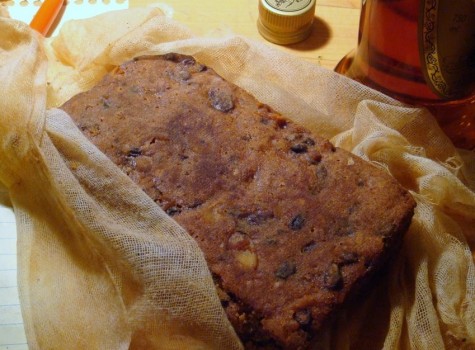
Unfortunately, I failed to make any proper notes about how I did it. And the anxiety of confronting the existing recipe (yield: 12 pounds, with my mother’s notes on top of her mother’s recipe, plus instructions to call my dad for extra advice) made me put off the project this year.
My fruitcake should have been soaking in brandy and rum since, oh, August would’ve been nice. But somehow that didn’t happen, and now it’s December. Which I had basically decided was too late.
But then I decided that the real point of Christmas baking is not so much to have sweets on hand for Christmas or parties or gifts or whatever. The point of it–of investing in the best cheap brandy at the liquor store (Paul Masson, my father avers), covering your kitchen in flour and giving yourself a sugar fit from tasting the batter too much–is to get yourself in the Christmas spirit. Really, nothing says holidays like dried fruit soaked overnight in booze. Or candied orange peel with brandy.
So, that’s what I did this weekend. I listened to the radio and baked. I tinkered with the recipe, and actually took notes. I was working off my mother’s typed recipe (on her old manual typewriter, which had cursive letters and no upper case), titled “mama’s fruitcake with incredible modifications.” Not sure what those modifications were, but in modern times, in the email she sent accompanying it, she wrote
beat in the 15 beaten egg yolks….beat egg whites until stiff but not dry and fold in. or add the eggs, beaten together all at once in the beginning, whatever.
I went with “whatever.” My feeling is that there’s barely any cake anyway–there’s only enough to hold all the fruit together–and it’ll be soaked with booze. So it doesn’t matter if it’s all airy and fluffy from the egg whites. But this is how knowledge gets lost, so I’m mentioning that option, just for the record.
Anyway, the result: a manageable four pounds of fruitcake, worth its weight in gold. It’s sitting downstairs, waiting for its brandy-soaking. So, it might not be at its peak at Christmas, but it will still taste good…and it’ll taste great in the depths of February, when I really need a brandy pick-me-up. And even more important: I now feel vaguely Christmas-y. Or maybe just drunk. Hard to tell.
Nana’s Fruitcake with Even More Modifications
This recipe is pared down from the original 12-pound yield to about 4 pounds worth of cake–I use one standard-size loaf pan plus two half-size loaf pans. But if you’re doing this for the masses, to give away, you can obviously scale the recipe back up–if you multiply by three, make it an even pound of butter and a pound of brown sugar.
1 pound golden raisins
1/2 pound currants
1 cup blanched, slivered almonds
1/2 cup pecans, roughly chopped
1/2 cup brandy (or 1/4 cup brandy and 1/4 cup port)
1 1/2 cups cake flour, sifted
1 tsp ground allspice
1 tsp ground nutmeg (about 1/2 a whole nutmeg)
1 tsp ground cinnamon
1/2 tsp salt
1/4 tsp baking soda
1/4 tsp baking powder
10 tbsp butter
3/4 cup packed brown sugar
5 eggs
For the candied orange peel:
2 oranges
1 tbsp brandy
1 tbsp water
4 tbsp sugar
The night before you’re planning to bake, toss the raisins, currants and nuts together in a container with a tight-fitting lid. Pour over the brandy (or brandy and port) and stir well to coat everything. Before you go to bed, flip the container, then flip it again in the morning–you want to distribute the booze well. In the morning, pour the fruit and nuts into a strainer placed over a bowl and let any remaining brandy drain out. Set the brandy aside for later.
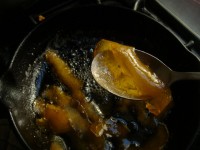 Make the candied orange peel: Wash your oranges well and, using a vegetable peeler, slice off the outermost layer of peel, taking as little of the white pith as possible. Chop the peel into fine slices (never mind that beautiful photo to the right–it’s much easier to slice the peel up before it’s candied). Set the peel in a heavy skillet and cover with water; simmer for 10 minutes, discard the water and add fresh (this is to remove some bitterness). Simmer for another 10 minutes, then drain. Combine the brandy and sugar with an additional 1 tablespoon of water. Pour this over the peel and and simmer until the peel is translucent and most of the liquid has cooked away. (You may need to add another tablespoon or so of water before the peel is properly clear.) Set out on parchment or waxed paper to cool.
Make the candied orange peel: Wash your oranges well and, using a vegetable peeler, slice off the outermost layer of peel, taking as little of the white pith as possible. Chop the peel into fine slices (never mind that beautiful photo to the right–it’s much easier to slice the peel up before it’s candied). Set the peel in a heavy skillet and cover with water; simmer for 10 minutes, discard the water and add fresh (this is to remove some bitterness). Simmer for another 10 minutes, then drain. Combine the brandy and sugar with an additional 1 tablespoon of water. Pour this over the peel and and simmer until the peel is translucent and most of the liquid has cooked away. (You may need to add another tablespoon or so of water before the peel is properly clear.) Set out on parchment or waxed paper to cool.
Preheat the oven to 275 degrees. Prepare your loaf or cake pans: butter and flour them, or line with parchment paper. (I make parchment slings, folded over each long side of the loaf pan, then butter each short side of the pan. Then you can lift the loaf out with the parchment wings.)
Proceed with the cake: Sift 1/2 cup of the flour over the drained fruit and nuts, tossing gently to cover everything. Sift the remaining 1 cup together with the allspice, nutmeg, cinnamon, salt, baking soda and baking powder.
With a mixer, whip the butter until light and fluffy. Add the sugar and continue beating until the butter lightens in color and the sugar dissolves. Add the eggs one at a time, beating well to incorporate each one. Turn the mixer to low and add half the flour-spice mixture. When it is incorporated, add 3 tablespoons of the brandy that was strained out of the fruits and nuts (make up the difference with fresh brandy if necessary). Then add the remaining flour. Fold in the fruits and nuts and stir well to combine.
Pour the batter into the pans and bake until evenly browned on top and firm–the cake should spring back when pressed lightly. This takes about 1 hour and 15 minutes for half-size loaf pans and 1 hour and 30 minutes for a full-size loaf pan.
Remove to a rack. When the loaves are cool, sprinkle with brandy and/or rum, then wrap tightly in cheesecloth and waxed paper. Store in a tin with a tight-fitting lid. Every week or so (or, if you’re on an accelerated schedule like me, every few days), drizzle the loaves with a bit more booze. Give them as much time as you can–inevitably, the cake will be at its best about a week after you finally give in and eat it.










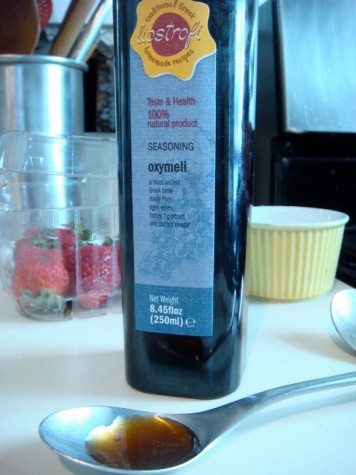 I’ve lived in Astoria for 11 years. There are lots of grocery stores here, and new foodstuffs all the time. But it’s been a long time since I’ve found something I’ve never even heard of: oxymeli. It was just sitting there, all innocent, on the shelf at my usual Greek grocery, Greek House on 30th Avenue. I love this guy because it’s the best kind of tiny store–the kind where the more you look, the more you see things you need. Also because he stocks a lot of
I’ve lived in Astoria for 11 years. There are lots of grocery stores here, and new foodstuffs all the time. But it’s been a long time since I’ve found something I’ve never even heard of: oxymeli. It was just sitting there, all innocent, on the shelf at my usual Greek grocery, Greek House on 30th Avenue. I love this guy because it’s the best kind of tiny store–the kind where the more you look, the more you see things you need. Also because he stocks a lot of 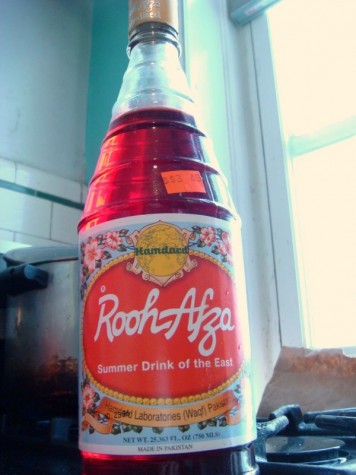 And because our pantry is overstuffed, I have to manage it the same way I do my clothes, tossing old to make room for new. The victim this time was a bottle of Rooh Afza, appealingly billed as “The Summer Drink of the East,” and smelling of rose and “fragrant screwpine.” Alas, it didn’t taste like much but sugar, and even its pretty label and ridiculous bright-pinkness couldn’t save it. Buh-bye, Rooh, and thanks anyway to Hamdafd Laboratories of Pakistan (though I love the sound of a drink made by Something Laboratories, don’t you?).
And because our pantry is overstuffed, I have to manage it the same way I do my clothes, tossing old to make room for new. The victim this time was a bottle of Rooh Afza, appealingly billed as “The Summer Drink of the East,” and smelling of rose and “fragrant screwpine.” Alas, it didn’t taste like much but sugar, and even its pretty label and ridiculous bright-pinkness couldn’t save it. Buh-bye, Rooh, and thanks anyway to Hamdafd Laboratories of Pakistan (though I love the sound of a drink made by Something Laboratories, don’t you?). 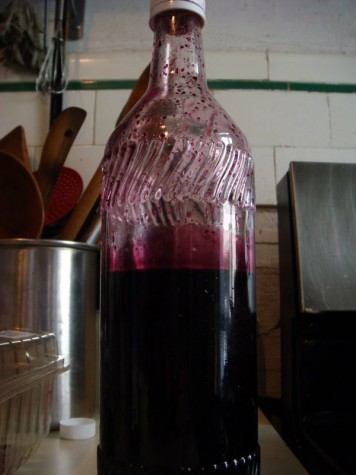 Oh, but I lie. I snuck in another new thing, without quite purging something else. It’s a bottle of mulberry syrup from Syria. It was a risky thing to bring back, considering it could have made a horrific mess in my luggage. But it’s intact (if now even already a third consumed), and in a drink-mixing frenzy over the last few days, I found it goes well with gin, and with bananas in a smoothie. Now that’s versatile–a real keeper.
Oh, but I lie. I snuck in another new thing, without quite purging something else. It’s a bottle of mulberry syrup from Syria. It was a risky thing to bring back, considering it could have made a horrific mess in my luggage. But it’s intact (if now even already a third consumed), and in a drink-mixing frenzy over the last few days, I found it goes well with gin, and with bananas in a smoothie. Now that’s versatile–a real keeper.